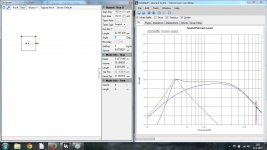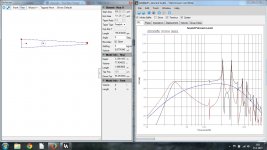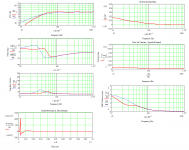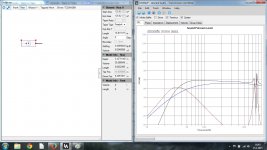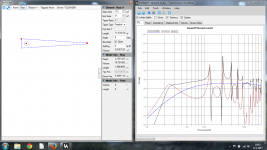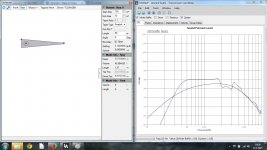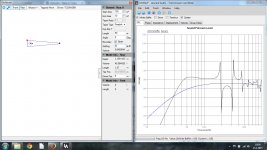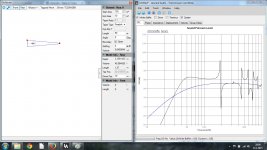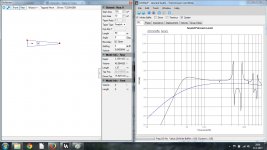Hello all,
I'm considering making a FAST active speaker for a friend using PLLXO and TPA3116 and Vifa TC18WG49 as bass driver and Vifa TC9FD as the full range. Initially I've thought about placing the full range in a about 3l sealed enclosure and crossing over with the woofer at about 300-400Hz area with 1st or 2nd order filter, not sure yet which one would be preferable. I'm also thinking on making the enclosure wide enough so the woofers low-pass will be below the baffle step freq.
What I'm still wondering is if I should place the woofer on a ported or a transmission line enclosure. I'm using the "Transmission Line" software to model the enclosures. Both yield a large, about 80l enclosure but size isn't a constraint on this build. Building a ported enclosure would certainly be easier, but I'm worried the bass will sound loose and boomy with it. Building a tapered TL would be quite complex as I'm aiming for about 1m high enclosure (and the small enclosure for full range on top), and folding the line along with the taper is a real pain in the *** to design and draw. Also the peaks and dips in response before the crossover in transmission line makes me want to rethink the type. The attached pictures are the enclosure options that cause me sleepless nights
I have REW and measurement equipment back online again when I get my primary computer fixed so I can measure the drivers and enclosures on my non-acoustically treated living room. I also got access to MJK worksheets, but no know-how on how to use them.
Any suggestions and advices? I've never build a FAST setup before
EDIT: Feel free to move this over to Multi-Way if that would be a more suitable forum for this thread.
I'm considering making a FAST active speaker for a friend using PLLXO and TPA3116 and Vifa TC18WG49 as bass driver and Vifa TC9FD as the full range. Initially I've thought about placing the full range in a about 3l sealed enclosure and crossing over with the woofer at about 300-400Hz area with 1st or 2nd order filter, not sure yet which one would be preferable. I'm also thinking on making the enclosure wide enough so the woofers low-pass will be below the baffle step freq.
What I'm still wondering is if I should place the woofer on a ported or a transmission line enclosure. I'm using the "Transmission Line" software to model the enclosures. Both yield a large, about 80l enclosure but size isn't a constraint on this build. Building a ported enclosure would certainly be easier, but I'm worried the bass will sound loose and boomy with it. Building a tapered TL would be quite complex as I'm aiming for about 1m high enclosure (and the small enclosure for full range on top), and folding the line along with the taper is a real pain in the *** to design and draw. Also the peaks and dips in response before the crossover in transmission line makes me want to rethink the type. The attached pictures are the enclosure options that cause me sleepless nights
I have REW and measurement equipment back online again when I get my primary computer fixed so I can measure the drivers and enclosures on my non-acoustically treated living room. I also got access to MJK worksheets, but no know-how on how to use them.
Any suggestions and advices? I've never build a FAST setup before
EDIT: Feel free to move this over to Multi-Way if that would be a more suitable forum for this thread.
Attachments
Last edited:
You are asking all the right questions and on the right track. I would use a second order PLLXO, 1st order has to much leakage, especially for a TL where you may want to suppress the higher harmonics. The 300-400Hz XO point is good and you may consider a short 13in long tapered TL of same 3liters with a 10:1 taper and filled with stuffing for the TC9FD. It has very little back reflections and provides some cone control. A Faital Pro 3FE25 is also very nice for this application. You may need a powerful preamp or use the headphone outputs to drive the PLLXO as they attenuate the signal. You will need to design the PLLXO with the input inpedance of the TPA3116 in mind. If using stock 26dB gain I think inpedance is 30kohms.
At some point, get a miniDSP. It will change your DIY life. Makes a huge difference in sound quality I FAST projects as the XO is infinitely adjustable in real time and you get EQ as bonus.
At some point, get a miniDSP. It will change your DIY life. Makes a huge difference in sound quality I FAST projects as the XO is infinitely adjustable in real time and you get EQ as bonus.
Last edited:
Hi,
Its all sensible except for the bass driver, which is best used sealed.
However if size is no constraint vented is possible and is easy.
Forget about loose and boomy with proper vented design.
Said driver, with 37Hz Fs, Vas = 44L and Qts = 0.47 works in :
35L sealed, which is a joke for a 6.5", and is probably intended
to work in about sealed 9L, for AV with 2dB of BSC built in boost.
Vented by definition is going to be interesting :
Great plot at 72L and 32Hz tuning but utterly meaningless.
However 35L tuned to 32Hz is very interesting compared
to 35L sealed. Much better with a very mild 0.6dB bump.
Practically because its not a great driver, 8.5oz magnet,
4mm excursion your best bet is 28L/1cuft tuned to 34Hz.
Don't oversize the port, let it choke at highest volumes.
rgds, sreten.
Its all sensible except for the bass driver, which is best used sealed.
However if size is no constraint vented is possible and is easy.
Forget about loose and boomy with proper vented design.
Said driver, with 37Hz Fs, Vas = 44L and Qts = 0.47 works in :
35L sealed, which is a joke for a 6.5", and is probably intended
to work in about sealed 9L, for AV with 2dB of BSC built in boost.
Vented by definition is going to be interesting :
Great plot at 72L and 32Hz tuning but utterly meaningless.
However 35L tuned to 32Hz is very interesting compared
to 35L sealed. Much better with a very mild 0.6dB bump.
Practically because its not a great driver, 8.5oz magnet,
4mm excursion your best bet is 28L/1cuft tuned to 34Hz.
Don't oversize the port, let it choke at highest volumes.
rgds, sreten.
Last edited:
As far as a TL variation is concerned, you could try a 10:1 taper ratio; 100in^2 throat, 10in^2 terminus. Axial length 50in on centreline; fold as desired maintaining the cross-section appropriate for that part of the line. Offset driver (centre) 5in down from the throat. Lag all internal faces with 3/4in acoustic fibreglass, Ultratouch, BAF or similar. Excuse the lack of optimisation, I'm pressed for time, but it should be a decent starting point.
Attachments
Last edited:
Thanks for the tips. Do you mean a closed TL for the TC9FD, similar to your nautaloss project? The speakers will be driven from computer, it's headphone output should be sufficient to drive even the 2nd order PLLXO.You are asking all the right questions and on the right track. I would use a second order PLLXO, 1st order has to much leakage, especially for a TL where you may want to suppress the higher harmonics. The 300-400Hz XO point is good and you may consider a short 13in long tapered TL of same 3liters with a 10:1 taper and filled with stuffing for the TC9FD. It has very little back reflections and provides some cone control. A Faital Pro 3FE25 is also very nice for this application. You may need a powerful preamp or use the headphone outputs to drive the PLLXO as they attenuate the signal. You will need to design the PLLXO with the input inpedance of the TPA3116 in mind. If using stock 26dB gain I think inpedance is 30kohms.
At some point, get a miniDSP. It will change your DIY life. Makes a huge difference in sound quality I FAST projects as the XO is infinitely adjustable in real time and you get EQ as bonus.
I considered miniDSP but am quite stressed about the budget for the speaker pair, so I just ordered a pile of resistors and capacitators from eBay for a fraction the price. This is why I'm also only using drivers I have on hand. I've had the Vifa bass drivers for 4 years and haven't figured out what to do with it, so maybe this project will be a good way to get rid of them
Thanks for the tips to you as well. I've simulated the driver in sealed enclosures, but I feel it would lack the bass for intented use (classic rock, movies, gaming). It would be absolutely the easiest alternative to build though. I also need to mention I actually have 4 of these drivers, so I can put 2 per speaker if it suits the purpose.Hi,
Its all sensible except for the bass driver, which is best used sealed.
However if size is no constraint vented is possible and is easy.
Forget about loose and boomy with proper vented design.
Said driver, with 37Hz Fs, Vas = 44L and Qts = 0.47 works in :
35L sealed, which is a joke for a 6.5", and is probably intended
to work in about sealed 9L, for AV with 2dB of BSC built in boost.
Vented by definition is going to be interesting :
Great plot at 72L and 32Hz tuning but utterly meaningless.
However 35L tuned to 32Hz is very interesting compared
to 35L sealed. Much better with a very mild 0.6dB bump.
Practically because its not a great driver, 8.5oz magnet,
4mm excursion your best bet is 28L/1cuft tuned to 34Hz.
Don't oversize the port, let it choke at highest volumes.
rgds, sreten.
What I don't understand is what you mean by 72l 32Hz enclosure being meaningless? It gives a good response on paper with slightly lifted bass at around 30Hz. On other hand, 35l at 32Hz gives a good slightly dropping curve. Would you consider the bigger enclosures peak disturbing in use? Picture of simulated response attached.
As far as a TL variation is concerned, you could try a 10:1 taper ratio; 100in^2 throat, 10in^2 terminus. Axial length 50in on centreline; fold as desired maintaining the cross-section appropriate for that part of the line. Offset driver (centre) 5in down from the throat. Lag all internal faces with 3/4in acoustic fibreglass, Ultratouch, BAF or similar. Excuse the lack of optimisation, I'm pressed for time, but it should be a decent starting point.
Thanks as well! I simulated this enclosure type, but I fail to see the good points in it. Maybe I didn't understand your explanation properly. Picture of simulated response attached.
Attachments
Thanks for the tips. Do you mean a closed TL for the TC9FD, similar to your nautaloss project? The speakers will be driven from computer, it's headphone output should be sufficient to drive even the 2nd order PLLXO.
Either sealed like Nautaloss, or put a small vent on the tail - works well too. Doesn't have to be precise - basically allows a means for energy to dissipate out and reduces reflections even further.
Thanks for the tips to you as well. I've simulated the driver in sealed enclosures, but I feel it would lack the bass for intented use (classic rock, movies, gaming). It would be absolutely the easiest alternative to build though. I also need to mention I actually have 4 of these drivers, so I can put 2 per speaker if it suits the purpose.
If you have two, double them up and run in parallel for +6dB sensitivity and use Linkwitz transform from your PC's EQ to extend bass. Basically a bass boost EQ of prescribed shape. You can get pretty good tight bass this way - I have tried it and it works well, just need to be realistic about max SPL's you intend to achieve.
Whilst a proper idea, using PC EQ is my last resort. I always try to plan the speakers to be as versatile as possible just in case, for example if my friend decides to plug them into his TVs headphone output instead of computers.If you have two, double them up and run in parallel for +6dB sensitivity and use Linkwitz transform from your PC's EQ to extend bass. Basically a bass boost EQ of prescribed shape. You can get pretty good tight bass this way - I have tried it and it works well, just need to be realistic about max SPL's you intend to achieve.
Thanks as well! I simulated this enclosure type, but I fail to see the good points in it. Maybe I didn't understand your explanation properly. Picture of simulated response attached.
Nor can I in the graph you post with a completely undamped pipe of different CSAs and length to the one I did above.
Last edited:
I blame sleep deprivation for my mistakesNor can I in the graph you post with a completely undamped pipe of different CSAs and length to the one I did above.See the plots I provided; this is with a line properly damped. The 'good points' should become fairly apparent: relatively flat amplitude response with little harmonic ripple, very flat / unreactive impedance load, reasonably well controlled driver behaviour (the two go hand in hand), decent GD with little ringing in the time domain, low terminus air velocity...
This time the graph is with real CSA and lenght. Looks a lot more like the ones you posted earlier. Damping is an interesting question. Previously, when I made a TL with Peerless P830986, I added damping only to areas that were the quarter wave "opening areas" of the harmonic peaks in the frequency graph. I applied 0,12 lb/cf of acoustic pillow padding. To my ear, it sounded a lot better than damping 2/3 of line lenght as per rule of thumb. I didn't have my measurement equipment at that time so I can't confirm how well it worked with measurements. I wonder if this kind of damping method actually works or was the difference only imagination.
Attachments
Follow-up question about the 1:10 driver alignment. I have never seen this type of alignment used in TL design (probably because I'm a newb). Why would this alignment be superior over the 1:5 bjohansen favours or the classic 1:3? Attached SPL undamped simulations of them all.Oh it certainly can -varies depending on design, the materials employed &c. The one I did above is nominally damped throughout for instance.
Attachments
Edit -I see what you mean, you're talking about the driver tap location. Different set of compromises, in this case for convenience. I did say it wasn't a fully optimised design. With that said, there is no one universal 'right' and varying positions have slightly different properties. The 5in location works OK once the line is damped properly, as shown above. I rarely favour a fixed place based on axial length alone.
Last edited:
Interesting. What kind of enclosure would you recommend this bass driver to then?Ignoring other issues and arguments: a TL 1.27m long is too long IMO, unless it's for a subwoofer. You will have anemic midbass and fatiguing sound. It won't be fun until a random low note comes up at around 50hz, which will sound good.
Ignoring other issues and arguments: a TL 1.27m long is too long IMO, unless it's for a subwoofer. You will have anemic midbass and fatiguing sound. It won't be fun until a random low note comes up at around 50hz, which will sound good.
Hmm. 'Anemic midbass and fatiguing sound.' If you say so Greg, but nothing in the design I did above, or 15+ years of designing TL variations leads me to believe that will be the case here. It's a nicely damped alignment to blend with typical room gain, has very little in the way of harmonic issues, and is an extremely unreactive load. Not a bad combination of characteristics.
What I don't understand is what you mean by 72l 32Hz enclosure being meaningless? It gives a good response on paper with slightly lifted bass at around 30Hz. On other hand, 35l at 32Hz gives a good slightly dropping curve. Would you consider the bigger enclosures peak disturbing in use? Picture of simulated response attached.
Hi,
72L is meaninglessly too big for the driver, It has a Vas of 44L
and would work fine in a sealed and well stuffed 14L/0.5cuft.
You want Vbox < Vas for good bass linearity and to reduce tuning
variations due to driver variability. Like I said, 28L tuned to 34Hz
is a good choice, the droop will work with room gain very well.
28L is still a big cabinet for a 6.5". The bass bump is minor.
rgds, sreten.
Thanks for the tip. I think computers headphone out can supply enough power for the PLLXO, and if not I can put a 2x150mW headphone amp before the PLLXO. I was wondering if the full range would actually even need a 2nd order, would the natural drop-off and 1st order be enough?Be careful with a 2nd order PLLXO. The roll-offs are really droopy (low Q), the HP amp will need at least a 50k input impedance, and the pre-amp will need a very low output impedance and have some welly.
dave
Also a question about phase alignment. I'm not very familiar with this concept at all, should I try to get the drivers in matching phase with adjusting the driver mounting depth on the front baffle. Also does it matter how far from eachother I place the drivers with such low XO frequencies? I don't mean to place them at opposite ends of baffle, but rather do they have to be right next to each other, bezels touching, or can there be a few inches between them?
The phase/time alignment and max distance between drivers are two different things.
Phase will depend on the type of woofer alignment you go with. Sealed is best to keep phase flat and time alignment (delay between full range and woofer) short. TL, BLH, BR, etc all have more time delay and phase shift compared to sealed or open baffle on the woofer. Sometimes the full range is set back in distance from the baffle plane to delay it relative to the woofer. The type of XO you use will also affect this.
The ROT (rule of thumb) distance between the drivers needs to be such that it is less than 1/3 the wavelength of the XO freq in order for the two to feel spatially coherent.
So for 350Hz XO: 342m/s x (1/350Hz) x 0.333 = 0.33m or 13in C-T-C spacing.
Phase will depend on the type of woofer alignment you go with. Sealed is best to keep phase flat and time alignment (delay between full range and woofer) short. TL, BLH, BR, etc all have more time delay and phase shift compared to sealed or open baffle on the woofer. Sometimes the full range is set back in distance from the baffle plane to delay it relative to the woofer. The type of XO you use will also affect this.
The ROT (rule of thumb) distance between the drivers needs to be such that it is less than 1/3 the wavelength of the XO freq in order for the two to feel spatially coherent.
So for 350Hz XO: 342m/s x (1/350Hz) x 0.333 = 0.33m or 13in C-T-C spacing.
- Status
- This old topic is closed. If you want to reopen this topic, contact a moderator using the "Report Post" button.
- Home
- Loudspeakers
- Full Range
- FAST with TL?
